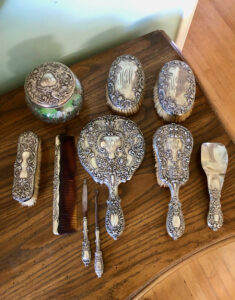 DS sent me a silver dresser set received as a gift to her grandparents in 1900. It came from the Sturtevant Family of Framingham, Massachusetts, a famous, indeed giant, name in the history of agriculture. Edward Lewis Sturtevant (1842-1898), with his brothers, developed a 200 acres study farm in Framingham. Their work on the farm resulted in his book, Edible Plants of the World of 1919. His daughter Gracie, who I suspect gifted DS’s grandparent this set, was herself a notable artist and botanist who specialized n the bearded iris. The family archives now live in the Missouri Botanic Garden Library, DS.
DS sent me a silver dresser set received as a gift to her grandparents in 1900. It came from the Sturtevant Family of Framingham, Massachusetts, a famous, indeed giant, name in the history of agriculture. Edward Lewis Sturtevant (1842-1898), with his brothers, developed a 200 acres study farm in Framingham. Their work on the farm resulted in his book, Edible Plants of the World of 1919. His daughter Gracie, who I suspect gifted DS’s grandparent this set, was herself a notable artist and botanist who specialized n the bearded iris. The family archives now live in the Missouri Botanic Garden Library, DS.
Why a dresser set for a wedding?
At that time people considered this kind of set de regueur for any real lady’s dresser. The number of implements indicated the aristocratic status of a lady. These days I take out my plastic, tangled Conair brush and plastic comb, and fish for a tooth brush each morning. I’m reminded of the great days when a woman with a vanity containing such splendor looked on a plastic comb, if plastic combs existed in those days, with despised.
What did a dresser set entail?
The heyday of the dresser set happened at the turn of the last century when you gifted such a thing to your child, your wife, or a newly married lady. It contained almost everything for grooming: a nail buffer, a brush or two, combs with tortoise shell teeth, a grand mirror with repoussé design containing a beveled mirror and ‘silvered’ glass-(difficult to replace these days), a few sizes of powder jars made of cut crystal with sterling lids, two sizes of lint brushes; one for cotton, with a flat head, one rounded for wool; perfume bottles with sterling topper, a cuticle knife, and a few nail files, trinket boxes, and a pin box, and sometimes a hat pin stand.
Imagine the entire wonderful gleaming set spread out quite effectively on the dresser, or better on your own sit–down vanity. Nowadays to find one fairly complete is RARE. So, DS owns a nice little treasure.
DS’s asked about her almost complete set, “Now that I don’t have the bandwidth to display such a treasure, what can I do with the set?’ I responded that perhaps she invest in a custom framer’s craft piece of a Lucite shadow box with a sleeve to let her polish the set once a year. She then asked, “if I don’t do that, how should I store the set?” I warned her not to use BAGGIES or any kind of plastic, as that will severely harm the silver. Those felt bags we used for our silver tableware are the best for storage.
Kings and Noble People Kept Massive Dresser Sets
I mention the rare 24K gold Tiffany dresser set that consisted of Body Powder cylinders, a few scent bottles, a soap dish, and the above ‘ingredients’ of brushes, mirror, combs, cuticle knife, files and so on. It sold in 2017 at Rago auctions for over $20,000.
Kings and Queens, and those who thought they should be Kings and Queens, owned dresser sets. These included a standing mirror surrounded by clustered gold or silver candlewicks for those inevitable night make-up sessions before the ball, along with a little coffee pot, a creamer and sugar bowl. Some incorporated a little dish for a small snack, along with the ‘ingredient’s you see above. Usually we find these grand sets ‘crested’ with the family insignia. DS’s came monogrammed.
DS writes that her grandmother worked as a nurse and her grandfather a salesman. I wonder about the connection to the Sturtevant family. Her grandmother must, at one point, have studied with biologist Grace Sturtevant. Grace would have been DS’s grandmother’s contemporary. If only the dresser set could speak! If her grandmother studied biology to become a nurse, then maybe they did meet in college?
The value of this set is $1,000. If it needs repair, such as to the mirror, the tortoise shell comb, the pounding out of dents, it will come at great expense. But I consider it worthwhile. The finest sets, in my opinion, are Art Nouveau, which usually feature a semi naked woman with flowing hair, a mixture of naturalism and erotica, peculiar to the period (1901-1925).